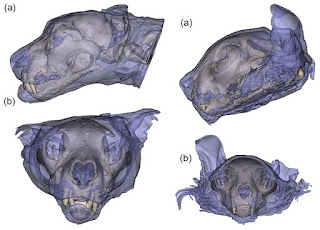 |
| Reconstruction of the external appearance of the head of Megantereon in different angles and with different facial expressions in Antón, Siliceo, Pastor, Jiangzuo et Salesa, 2024. |
Abstract
Megantereon was a widespread saber-toothed felid from the Pliocene and Pleistocene of the Old World and North America, but its rarity in the fossil record makes it complicated to restore its life appearance. Lack of complete specimens makes it necessary to combine information from fossils of different individuals to reconstruct their facial anatomy. In this work, we combine the analysis of skulls and mandibles of Megantereon from various fossil sites with the study of extant carnivorans through dissection, 3D scans, and the observation of live individuals. Megantereon combined very elongated upper canines with mandibular flanges that were not deep enough to match the length of the sabers, as well as a wide maxilla combined with narrow incisor rows and mandibular symphysis. Such features are compatible with the presence of exposed canines in life, because the narrow symphysis allows room to accommodate lips and other soft tissues medial to the sabers, while the protrusion of the tips of the upper canines beyond the mental flanges makes it unlikely that they would be enveloped in soft tissue sheaths, which would dangle with the inherent risk of puncture. Megantereon was transitional between saber-toothed felids with covered upper canines, where saber length fits with mental flange depth, and the derived Smilodon where the upper canines are much longer than the flanges and the lips fit between upper canines and mandible, leaving the upper canine crowns largely exposed in life.
Keywords: anatomy, muscles, Paleobiology, Smilodontini
Mauricio Antón, Gema Siliceo, Juan Francisco Pastor, Qigao Jiangzuo and Manuel J. Salesa. 2024. Exposed Weapons: A Revised Reconstruction of the Facial Anatomy and Life Appearance of the Saber-toothed Cat Megantereon (Felidae, Machairodontinae). The Anatomical Record. DOI: doi.org/10.1002/ar.25622




